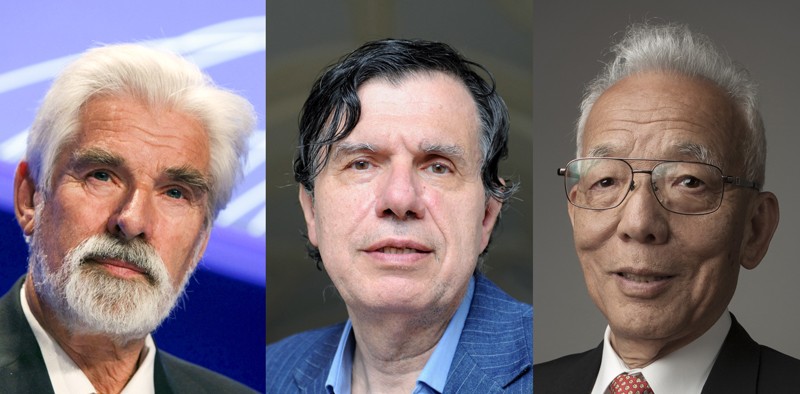Three researchers have won the 2021 Nobel Prize in Physics for their work on describing complex physical systems — including foundational research that created a pioneering mathematical model of Earth’s climate and predicted that increasing levels of carbon dioxide in Earth’s atmosphere would raise global temperatures.
Syukuro Manabe and Klaus Hasselmann share half of the 10-million Swedish kronor (US$1.15-million) prize for this modelling. Theoretical physicist Giorgio Parisi at the Sapienza University of Rome shares the other half of the prize for his contributions to the theory of complex systems. His work has affected many areas, from neuroscience to how granular materials pack, the Nobel committee said in its announcement on 5 October.
“These are two different prizes, but there is the common theme that has to do with this order, these fluctuations together that can give rise to something that we can understand and predict,” said Thors Hans Hansson, chair of the physics Nobel committee. “We can predict what is happening with the climate in the future if we know how to code the chaotic weather.”
Climate models
Manabe, now at Princeton University in New Jersey, showed in the 1960s how increased levels of carbon dioxide in Earth’s atmosphere leads to increased temperatures at the surface, and developed early mathematical models of the planet’s climate. Around a decade later, Hasselmann, of the Max Planck Institute for Meteorology in Hamburg, Germany, built on this work to create a model linking weather and climate.
“Manabe showed us how and why increasing CO2 leads to global warming. Hasselmann showed that it is happening,” says climate scientist Bjorn Stevens, also at the Max Planck Institute of Meteorology. He adds that the institute is “thrilled” that the pair have been awarded “first Nobel prize for the science underpinning our understanding of climate change”.
Jürgen Kurths at the Potsdam Institute for Climate Impact Research says that a “genius contribution” of Hasselman’s was the introduction in the 1970s of the first ‘conceptual model’ for Earth’s climate — a simple set of equations that captures global phenomena with just a few variables. This approach has given complementary insights to those from global circulation models, which are brute-force, geographically detailed calculations. “Usually you need a computer to simulate [conceptual models], but it’s much faster and easier,” Kurths says.
Despite Hasselman’s advanced age — 89 years old — he continues to actively follow the field, and encourages researchers to try non-traditional approaches, Kurths adds.
Gabriele Hegerl, a climate modeller at the University of Edinburgh, UK, who worked with Hasselman as a postdoctoral researcher says he was a “fantastic” mentor and supervisor, who was “full of ideas and enthusiasm”.
“I am really pleased that Suki and Klaus were chosen together, as they both contributed hugely in different ways and are two giants of climate science,” she adds. “I still use Suki’s old figures from the early papers on absorption and physics of the atmosphere in my classes, and his work is fundamental to understanding climate and with it, climate change.”
Manabe was “gobsmacked” when he heard he had won the prize, said John Wettlaufer, an Earth and planetary scientist at Yale University in New Haven, Connecticut, who was a member of the physics Nobel committee. “He said, ‘But I’m just a climatologist.’.”
Hidden order
Parisi started his career in particle physics, but his research has since touched many other subfields. In the late 1970s, he switched his attention to the theory of complex systems, where he discovered a hidden and counter-intuitive type of order in the interactions of many objects. In simpler systems — such as magnetic materials, for example — atoms tend to align parallel to their neighbours, but complex systems are less predictable. Still, Parisi discovered that they satisfy a kind of symmetry that is only noticeable when comparing how the individual atoms arrange over different scales, says physicist Federico Ricci-Tersenghi at Sapienza.
“He opened up a way to see and interpret complex phenomena that until then had been missed,” says Ricci-Tersenghi, who is a former student of Parisi and a long-time collaborator. The theory turned out to be useful even for systems that at first sight appear to be completely random, such as the structure of glass, he adds.
Parisi’s research looks at the underlying disorder and fluctuations and predicts emerging behaviour, said Wettlaufer. The link between his, Manabe’s and Hasselmann’s work is that fluctuations are key for predictability, he said. “We’re recognising that emerging phenomena sometimes require you to look at all the individual complicated physical mechanisms and knit them together to make a prediction.”
Kurths says that he was pleased that Parisi — and with him the study of complex systems, which is crucial to understanding the climate — received recognition from the Nobel Committee.
Parisi has also fostered a “happy environment” in his research group, Ricci-Tersenghi says, and has always encouraged his mentees to follow their curiosity and intellectual interests.
Reacting to news of his Nobel win, Parisi told reporters during the announcement: “I was very happy and I was not really expecting it” “But I knew I had some chance — so I kept the telephone near me.”
The award comes before a pivotal climate conference — the 26th United Nations Climate Change Conference, due to take place in Glasgow, UK, in November. “It’s very urgent that we take a very strong decision and move at a very strong pace,” said Parisi, of the climate negotiations. “For the future generations, we have to act now in a very fast way.”
Asked if the Nobel committee was sending a message to world leaders with the award, Göran Hansson, secretary-general of the prize-awarding Royal Swedish Academy of Sciences, said: “What we are saying is that the modelling climate is solidly based in physical theory and solid physics.” He added: “Global warming is resting on solid science. That is the message.”
"share" - Google News
October 05, 2021 at 06:32PM
https://ift.tt/3oz3WuH
Climate modellers and theorist of complex systems share physics Nobel - Nature.com
"share" - Google News
https://ift.tt/2VXQsKd
https://ift.tt/3d2Wjnc
Bagikan Berita Ini


















0 Response to "Climate modellers and theorist of complex systems share physics Nobel - Nature.com"
Post a Comment